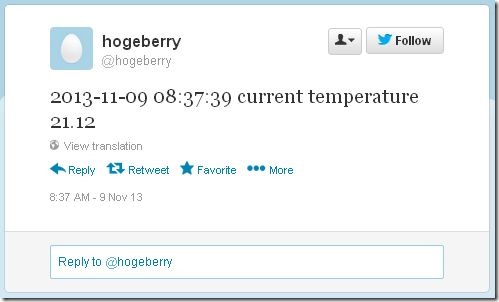つづき。
Pythonでtwitterを扱うライブラリは何種類か存在しているが、ここでは tweepy を使用する。最初に試してみたのがたまたまこれだったというだけで、特に理由があって選択したわけでは無い。あえて言うならpipで簡単にインストールできたから、というのが理由。
Raspberry Piにpipがインストール済みであれば
$ pip install tweepy
でインストールできる。
pipがインストールされていない場合は、その前に
$ easy_install pip
でインストールしておく。
easy_installもインストールされていない場合は、さらにその前に
$ sudo apt-get install python-setuptools
でインストールしておく必要がある。
tweepyが正常にインストールできたかどうかは、シェルでpythonを起動して「import tweepy」と入力すれば良い。何の警告も出なければ正常。
tweepyを使用して単純にツイートさせるプログラムは、以下のようになる。
#!/usr/bin/env python
import tweepy
import datetime
import locale
consumer_key = "xxxxxxxxxxxxx"
consumer_secret = "xxxxxxxxxxxxxxxxxxxxxxxxxxxxxxxxxx"
access_key = "xxxxxxxxxxxxxxxxxxxx"
access_secret = "xxxxxxxxxxxxxxxxxxxxxxxxxxxxxxxxxxxxxxxxx"
auth = tweepy.OAuthHandler(consumer_key, consumer_secret)
auth.set_access_token(access_key, access_secret)
api = tweepy.API(auth_handler=auth)
date = datetime.datetime.today()
api.update_status(date.strftime("%Y-%m-%d %H:%M:%S"))
consumer_key 、consumer_secret 、access_key、access_secretには取得済みのコードをそのまま記述。実行すると以下のように現在時刻がツイートされるはず。
これだけでは面白くないので、 少し手を加えてI2C温度センサーからのデータをツイートさせてみる。プログラムは以下の通り。
#!/usr/bin/env python
# -*- coding: utf-8 -*-
import smbus
import time
import tweepy
import datetime
import locale
class i2c:
def __init__(self, bus, addr):
self.b = smbus.SMBus(bus)
self.addr = addr
def put(self, cmd, data):
self.b.write_byte_data(self.addr, cmd, data)
def get(self, cmd):
return self.b.read_byte_data(self.addr, cmd)
def getblock(self, cmd, len):
return self.b.read_i2c_block_data(self.addr, cmd, len)
class tweet:
def __init__(self):
self.consumer_key = "xxxxxxxxxxxxxxxxxxxxxxx"
self.consumer_secret = "xxxxxxxxxxxxxxxxxxxxxxxxxxxxxxxxxxxxxx"
self.access_key = "xxxxxxxxxxxxxxxxxxxxxxxxxxxxxxxxxxxx"
self.access_secret = "xxxxxxxxxxxxxxxxxxxxxxxxxxxxxxxxxxxxxxx"
def tweet(self, msg):
auth = tweepy.OAuthHandler(self.consumer_key, self.consumer_secret)
auth.set_access_token(self.access_key, self.access_secret)
api = tweepy.API(auth_handler = auth)
api.update_status(msg)
if __name__ == '__main__':
date = datetime.datetime.today()
tw = tweet()
dev = i2c(1, 0x48)
result = dev.getblock(0x00, 12)
temp = (result[0] << 8 | result[1]) >> 3
if(temp >= 4096):
temp -= 8192;
msg = '{0} current temperature {1:7.2f}'\
.format(date.strftime("%Y-%m-%d %H:%M:%S"), temp / 16.0)
tw.tweet(msg)
実行すると現在の気温付きでツイートされる。室温21.12度。
あとは一定時間で自動的にツイートするようにすれば、twitterで何かのデータを監視をするシステムに応用できるはず。ただしtwitterAPIを使用したツイートには回数制限があるため、短時間に大量のツイートを行うようなプログラムは規制に引っかかる可能性がある。
将来的にtwitterAPIの仕様が変更になる可能性もあるので、注意が必要。

